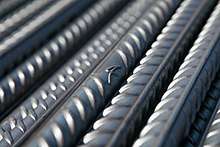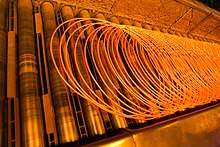ArcelorMittal Kryvyi Rih
ArcelorMittal Kryvyi Rih (former Kryvorizhstal (Ukrainian: Криворіжсталь) is Ukraine's largest integrated steel company located in Kryvyi Rih city.
 | |
Native name | АрселорМіттал Кривий Ріг |
|---|---|
| public joint-stock company (PJSC) | |
| Industry | Steel |
| Founded | 1934[1] |
| Founder | Supreme Soviet of the National Economy |
| Headquarters | , Ukraine |
Key people | Mauro Longobardo (CEO) |
| Products | Steel, hot metal, rolled products |
Number of employees | over 20,000 (2019) |
| Parent | ArcelorMittal |
| Website | ukraine |


Bought in 2005 by Mittal Steel, the plant is one of the most important businesses in Ukraine and a globally important steel producer. In Ukraine it is the largest steel manufacturer of both rebar and wire rod. Also ArcelorMittal Kryviy Rih specializes in manufacturing of sections, angles, strips and billets. Steel plant produces over 6 MT of crude steel, 5 MT of rolled products and 5.5 MT of hot metal.
Production
Located fully in Kryvyi Rih, this steel company was built as an integrated mining and steel plant, comprising:
- iron ore mines
- ore processing factories and two open-pits
- coke-processing plant
- three sinter shops
- steel workshops of different types (two blast furnace shops, blooming)
- three metal-rolling workshops.
Production Volumes of 2019
- Ore mining - 24.5 mln tons
- Concentrate - 9.8 mln tons
- Sinter - 9.8 mln tons
- Coke 6% moisture - 2.8 mln tons
- Hot metal - 5.3 mln tons
- Steel - 5.3 mln tons
- Rilled products - 4.7 mln tons.
Background
The presence of iron ore in the regions around Kryvyi Rih has been known since at least 1781 and was rumoured before;[1] being known to the ancients. Throughout the 1800s the region was investigated for its mineral wealth. Iron ore of 70% iron content and manganese ores were found. In 1881 the industrial extraction of iron ore began, alongside other developments such as the construction of Kryvyi Rih railway. By 1884 over 100 000 tons of iron ore had been extracted, and the railway though Kryvyi Rih, 477 versts (505,6 km) long, from Yasynuvata station via Kryvyi Rih to Dolynska station had been opened.[1] The production expanded rapidly in the next years. By 1896 there were 20 mines producing over 1 000 000 tonnes of ore in Kryvyi Rih Basin. Industrial expansion continued in the region up to 1917. Production dropped during the first world war.[1]
Foundation and growth in Soviet Union
After the formation of the Soviet Union and the expulsion of Austro-Hungarian forces and then anti-communist forces under Anton Denikin occupying the region relative normalcy was resumed.[1] Planning of the plant began in 1929, with the intention being to produce an integrated steel plant taking iron ore and carbon all the way to finished steel products.[3] In 1931 the chairman of the Supreme Economic Council of the USSR - Grigori (Sergo) Ordzhonikidze signed a decree ordering its construction and the same year the foundation stone of the metallurgical plant was laid. In August 1934 the first metal was produced at Kryvorizhstal; later known as 'Kryvyi Rih Metallurgical Plant'.
Before the onset second world war the plant operated with 3 Blast Furnaces (of 3 160 m3) and 2 open hearth furnaces along with a heat and power plant. In 1941 a blooming mill of 1.7 million tonnes p.a., fourth Blast Furnace and third open hearth furnace came on line shortly before nazi occupation.[4]
Prior to occupation by German military forces equipment and employees were evacuated to Nizhny Tagil.[4] During the German administration (from the 14th of August 1941 to the 22nd of February 1944[1]), the plant was destroyed.,[5]
After the recapture of the area the plant was rebuilt, and continued to grow again. Blast Furnace No.7 was built in 1962 and Blast Furnace No.8 was built in 1970, making the plant the largest in Europe. In 1974 Blast Furnace No.9 was opened[1] the biggest in the world with a volume of 5 000 m3.[6]
Ukrainian independence
In 1996 restructuring took place, combining the mining and ore concentrating unit Novokrivorozhsky HZK (Новокриворізький ГЗК (НК ГЗК)) (NK-HZK) with the Kryvyi Rih State Mining and Metallurgical Combine (Kryvorizhstal) (Криворізького державного гірничо-металургійного комбінату "Криворіжсталь") into one unit. Kryvyi Rih coking plant[7] (Криворізький коксохімічний завод (ККХЗ)) was included in the group in 1997,[6] forming "Novokrivorozhsky mining and processing combine and Kryvyi Rih coking plant" (Новокриворізький гірничо-збагачувальний комбінат і Криворізький коксохімічний завод «Криворіжсталь») or simply Kryvoriszhstal. Technically this was simply a paper exercise, three units had been always been designed to work jointly, and the factory facilities were on the same site.
In 2004 it became a public company and was privatised.[6]
First privatization, 2004
Kryvorizhstal became internationally known when it was privatized in June 2004 for a sum of US$800 million,[8][9] (4.26 billion Hryvnia.[10]) against a government-set reserve price of $714 million,[11] to a consortium called Investment-Metallurgical Union. This consortium included Rinat Akhmetov's SCM and Interpipe Group,[10] controlled by then-President Kuchma's son-in-law Viktor Pinchuk.[9] Higher offers from foreign investors including a joint bid from Severstal/Arcelor, and a bid from Tata Steel were rejected on bidding technicalities.[12] The deal was widely criticized by the opposition and abroad as an example of corruption and state property mismanagement.[9]
By initiative of the new President Viktor Yushchenko, the privatization deal was dismissed by the court in June 2005, in order to sell the company again in a fair auction.[9]
2005, Second privatisation and ArcelorMittal company
At the time of the second privatisation the company had annually sales of $1897 million with a net profit of $378 million, and cash of $413 million. The plant had a production capacity of ~10 million tonnes of raw steel, and rolling capacity for under 7 million tonnes, and was able to source most of its requirements for iron ore and coke locally.[13] The bidding process was broadcast live on Ukrainian television,[9] with Arcelor, Mittal Steel and Vadim Novinsky's Smart Holdings bidding - Mittal Steel was the highest bidder and acquired a 93.02 percent stake in Kryvorizhstal on October 24, 2005, for 24.2 billion hryvnia (US$4.81 billion)[9] - Mittal Steel was expected to finance the acquisition from its own cash reserves and from a $3 billion loan arranged with UK based Citigroup. The price exceeded analyst predictions of $3 billion,[13] making it the largest privatization deal in the former Soviet Union.
In 2006 the company was renamed as Mittal Steel Kryvyi Rih[14] (Ukrainian : ВАТ «Міттал Стіл Кривий Ріг»), later in 2007 after the takeover of Arcelor by Mittal steel to form ArcelorMittal the company was renamed as ArcelorMittal Kryvyi Rih.[15]
During the late-2000s financial crisis steel production decreased from 8.1 million tonnes in 2007,[16] to 6.2 million tonnes in 2008,[17] and to 5 million tonnes in 2009,[18] with decreases in other production metrics, as well as revenues, with the business making a net loss of 120million UAH in 2009 (from a profit of 4.7 billion UAH in 2008).[19] Production levels recovered to 2008 values in 2010.[20][21]
Investments
Over the last 14 years in Ukraine, the company's total investments amounted to USD 9.7 bln (US$4.85 bln - the acquisition value + USD 4.4 bln - investments in the production development).
Major investment projects (2006-2019):
- Reconstruction of coke oven batteries No. 3 and No. 4 (US$199 mln);
- Category 1 reconstruction of Blast Furnace No. 8 (US$127 mln);
- Reconstruction of oxygen block No. 2 (US$45 mln);
- Construction of ladle furnace and continuous caster machine No. 1 (US$112 mln);
- Construction of the new packing line at light section mill No. 2 (US$16 mln);
- Category 1 reconstruction of Blast Furnace No. 6 (US$117 mln);
- Pulverized coal injections construction at Blast Furnace No. 9 (US$60 mln);
- Reconstruction of coke oven batteries No. 5 and No. 6 along with implementation of environmental measures and automated environmental monitoring system (US$157 mln);
- Modernization of Sinter Shop No. 2 (over US$180 mln);
- Construction of two new continuous casting machines No. 2 and No. 3 (over US$160 mln);
- Reconstruction of light section mill No. 250-4 (over US$60 mln);
- Construction of new gas cleaning plants for Basic oxygen furnaces No. 4, No. 5, No. 6 with СО combustion and implementation of automated environmental monitoring system (US$65 mln);
- Since 2008 till 2015 total ca. USD 500 mln were invested to replenish old crushers, to build new sections at the beneficiation plants (total 3 sections), to purchase new ball mills, to modernize the haulage fleet and in-pit equipment, to open a new horizon at Artem underground mine (1 135 m), to reconstruct the tailing ponds.
Mauro Longobardo appointed as Chief Executive Officer of ArcelorMittal Kryvyi Rih, effective from February 18, 2020.
See also
References
- "Historical chronicle of events (Kryvyi Rih City) 1734-1900", kryvyirih.dp.ua, archived from the original on 13 July 2007
- "Mittal Steel Company Acquires a 93% Stake in Kryvorizhstal in Ukraine", www.prnewswire.com, Mittal Steel Company NV, 24 Oct 2005
- Парадоксальные воспоминания о будущем КРИВОРОЖСТАЛИ. Bittersweet memories of the future KRYVORIZHSTAL h.ua
-
N. A. Gurov (July 1979). "Phases of large growth — The 45th anniversary of the Krivorozhstal' plant". Metallurgist. Springer New York. 23 (7): 439–443. doi:10.1007/BF00736640. ISSN 0026-0894.
Krivorozhstal' Plant. Translated from Metallurg, No. 7, pp. 6–8, July, 1979.
- Кривой Рог - город шахтеров и металлургов Archived 2010-02-26 at the Wayback Machine Kryvyi Rih -- city of miners and metallurgists www.krivbassham.org
- АрселорМиттал Кривой Рог (Криворожсталь) ArcelorMittal steel (Kryvorizhstal) file.liga.net
- КРИВОРОЖСКИЙ КОКСОХИМИЧЕСКИЙ ЗАВОД Kryvyi Rih Coke plant chem2.expoweb.ru
- Marat Terterov, ed. (2006), "1. Editor's Introduction - Roses, Oranges and Foreign Investors", Ukraine Since the Orange Revolution: A Business And Investment Review, GMB Publishing Ltd, p. 8, ISBN 184673004X
- John Marone (19 March 2010), "Monopolies thrive as toothless state bows to moguls", www.kyivpost.com, Kyiv Post
- Чистая прибыль "Криворожстали" составила 2012,610 млн. гривен, ukrrudprom.com (in Russian), 15 June 2005
- Alex Nicholson (14 May 2004), "Severstal Warns Kiev Over Major Sell-Off", www.themoscowtimes.com, The Moscow Times,
Ukraine has set a minimum bid of $714 million for 93.1 percent of Kryvorizhstal, one of Ukraine's few profitable metals companies. It reported pre-tax profits of $302 million last year and has a capacity of 6 million tons of rolled steel, 7 million tons of steel and 7.8 million tons of pig iron
- Как закалялась "Криворожсталь"!, rosinvest.com (in Russian), 16 August 2005
- "Mittal buys Ukraine's Kryvorizhstal for 4.81 bln usd - UPDATE", www.forbes.com, AFX News Limited via Forbes, 24 October 2005
- Krivorozhstal renamed as Mittal Steel Kryvyi Rih Archived 2011-07-16 at the Wayback Machine 14 January 2006, via steelguru.com
- "Mittal Steel Kryvyi Rih" renamed for "ArcelorMittal Kryvyi Rih" 22.06.2007 www.kmu.gov.ua
- "ArcelorMittal Fact Book 2007" (PDF), www.arcelormittal.com, ArcelorMittal, p. 129, June 2007
- "ArcelorMittal Fact Book 2008" (PDF), www.arcelormittal.com, ArcelorMittal, p. 97, June 2008
- "ArcelorMittal Fact Book 2009" (PDF), www.arcelormittal.com, ArcelorMittal, p. 97, June 2009
- "ArcelorMittal Kryviy Rih: overview of 2009", www.arcelormittal.com, ArcelorMittal, 16 March 2009
- "ArcelorMittal Fact Book 2010" (PDF), www.arcelormittal.com, ArcelorMittal, p. 30,77, July 2011
- "OJSC "ArcelorMittal Kryviy Rih" announces its November production results", www.arcelormittal.com, ArcelorMittal, 17 December 2010
Sources
- Dan Stern (2011-04-06), "Testing the mettle of Ukraine's steel city", news.bbc.co.uk, BBC World News